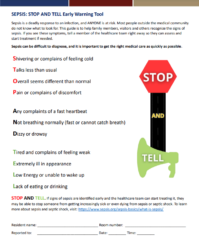
In North Dakota and South Dakota, sepsis is the #1 admission and readmission diagnosis. With sepsis, time is of the essence. For every hour of delayed treatment, the risk of death increases by between 4 and 9 percent.¹ Experts say that 80 percent of sepsis deaths could be prevented if treated in time.
Our team wanted to develop a tool that could help family members and non-clinical staff; i.e., nutritional services, environmental services and maintenance identify the early signs of sepsis. We created a ‘spin off’ of the Stop and Watch tool, an early warning tool to prompt staff to be alert for potential changes in condition indicators and offers a simple way to communicate changes to nursing staff.
Access the Sepsis: STOP and TELL tool. If a resident shows any of the signs illustrated on the tool, a clinical staff person is to be notified immediately. This is the first step in an early intervention for a person with sepsis. It’s important to look for a combination of the warning signs of sepsis. Spotting these symptoms early could prevent the body from entering septic shock and could save a life.
This tool can be placed in a resident room, included in an admission packet, hung at a central location or posted in rooms or on doors. We hope that by educating non-clinical staff and family members and encouraging them to speak up, we can all make a difference in the identification and treatment of sepsis.
- National Sepsis Alliance

Listen to our Podcast – Q-Tips For Your Ears
TIME is Sepsis, Have You Heard? Sepsis is a medical emergency as important to understand as stroke and heart attack. Learn the symptoms and what you should say to your healthcare provider when you suspect sepsis.
